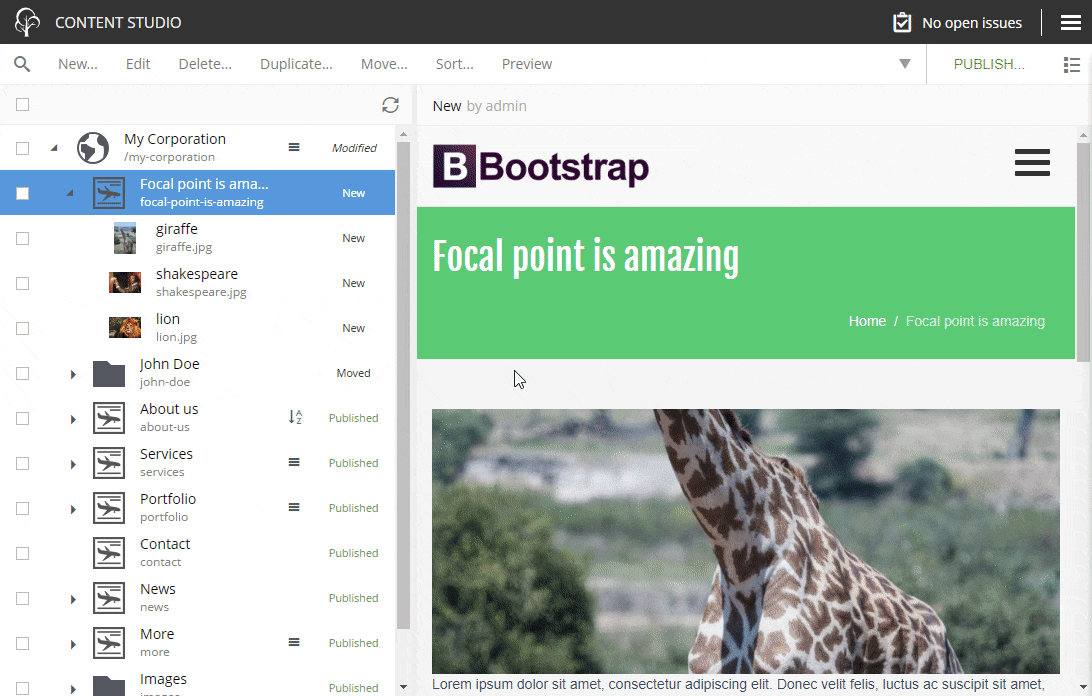
9 Features That Make a Great CMS
The top features you need in order to have a simple, flexible and responsive digital experience.
Written by Vegard Ottervig on
There are loads of content management systems on the market, all offering slightly different feature line ups. But with so many options to choose from, it can seem like a real jungle out there. So, in this feature free for all, what are the tools that your CMS absolutely must have?
1. Drag and Drop
Sounds too simple to be kicking off a list about top flight CMS features, right? Well, drag and drop functionality is not to be underestimated, as you’re certain to miss it if it isn’t there.
Drag and drop is usually implemented through the admin console and will save you heaps of time and frustration by helping you upload images and files, sort the order of content or images, and drag components around your landing page.
Simply put, drag and drop makes for a more responsive CMS.
2. Image Handling
What CMS doesn't support image handling, you ask? Well, most of them do, but how well they do it is another question entirely. Many websites use templates in order to put images into a certain aspect ratio, and if you upload an image with an incompatible aspect ratio (for instance a portrait format where there should be landscape), the results will be a crushed picture.
A great CMS not only supports editing like crop, rotate, and flip, but it should also support focus points. So when you come along with that portrait of a standing person, you can safely upload and assign focal point to the face, even if the given template specifies the shown image to be in narrow landscape mode.
3. Easy to Use
Your CMS should be simple to understand and use for everyone. The journey of an idea from conception to completion should be simple and seamless for all the contributors along the way. This is the only way to deliver a top quality digital experience.
Intuitive and easy navigation are the key elements in this equation. Adherence to UX and accessibility principles, as well as a responsive design compatible with small screens for when you are on the go, are also paramount. A visual tree structure for keeping your content tidy will also contribute greatly to the user experience.
All of these elements can further be boosted by video tutorials, blog posts, or other training resources.
Read more: How to Optimize the Website User Experience in 3 Steps »
4. Multilingual Support
The growth of eCommerce and mobile are making geographic borders irrelevant. Expanding your business into other countries and regions shouldn’t be held back by your CMS, so it’s important that it can expand to different languages.
To help with the translation process, look for a CMS with multilingual capabilities such as supporting any character (UTF-8), as well as something akin to a layers system.
5. Flexibility
Creating content in new and exciting ways is a key element in the race to stay ahead of your competition. Therefore, choosing a CMS that’s flexible enough to allow you to achieve even the most ambitious content goals is really important.
A great question to ask is whether the CMS can support highly structured content like recipes or products. You also want a CMS that makes it easy to manage your landing pages without bringing in a developer.
See how you can use a CMS to its fullest potential »
6. Version Control
The usefulness of version control is not limited to traceability and auditing. You’ll soon find it’s like a digital guardian angel, protecting you and your editorial team from careless errors (like when you accidentally delete that piece of content that’s taken hours to produce). That kind of disaster can send even the calmest person into a panic, which is why being able to simply go back to the archived version you need is so important.
As an added bonus, version control may allow you to make edits to already published content without having to worry about messing up the live version.
7. Security
Putting in a little extra time to make sure you select a secure CMS will be worth it in the long run. If it is not already on your wanted features list, you should put it there.
Break-in attempts are becoming increasingly common. Breaches in your security, especially in how you handle private customer information, will cause huge reputational damage to your brand. Be sure to find a vendor that takes security seriously, e.g. by using an OWASP test.
Discover How You Can Find a New CMS »
8. Open APIs
An API (application programming interface) makes it possible for applications to share data and interact with each other. This is essential if you want your system to scale with your business, and allow you to take advantage of best of breed third party services.
For a future proof CMS, having the ability to seamlessly integrate your business systems and services is a no brainer. Make sure that your prospective CMS adheres to API first principles, i.e. that structured content has primacy and that the API is powerful and flexible enough to connect to whatever you desire.
9. Support
You want to be in a safe pair of hands when it comes to your CMS provider. A great provider will offer support plans that fits your requirements and training programs to get you up to speed quickly.
If you plan to run your project with in house developers, you also want to make sure there’s a vibrant community to help them. Do your research, ask around. And you will be rewarded.
***
With these must have features up your sleeve, you’ll have no problems finding a CMS that will make life easier for your digital team, all while boosting the quality of your user experiences.
Good luck in your search!
First published 25 June 2018, updated 18 January 2024.


